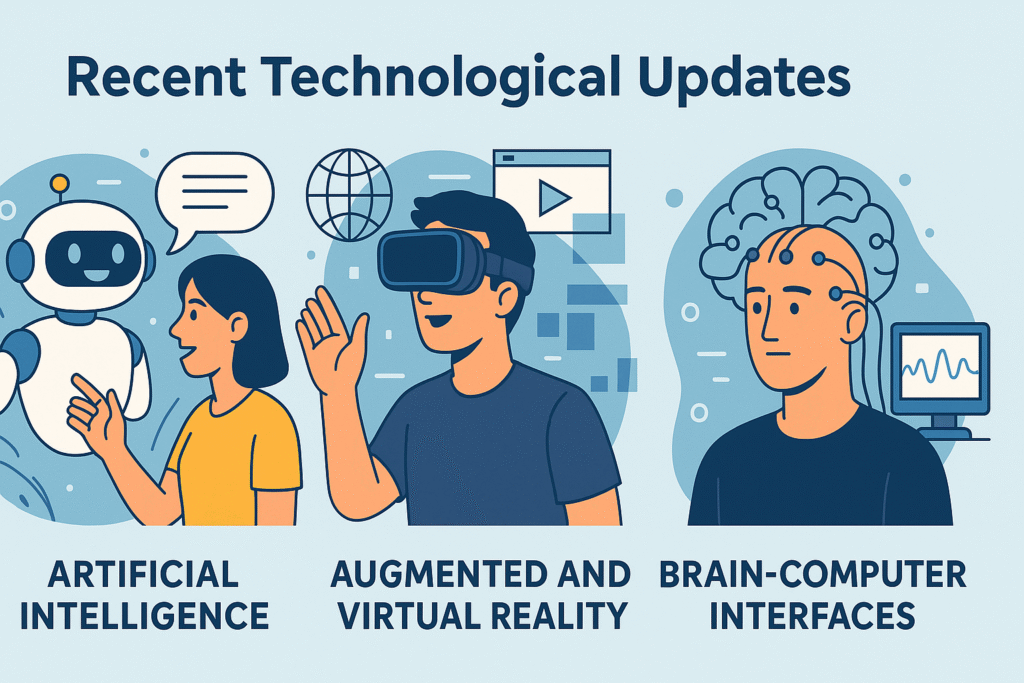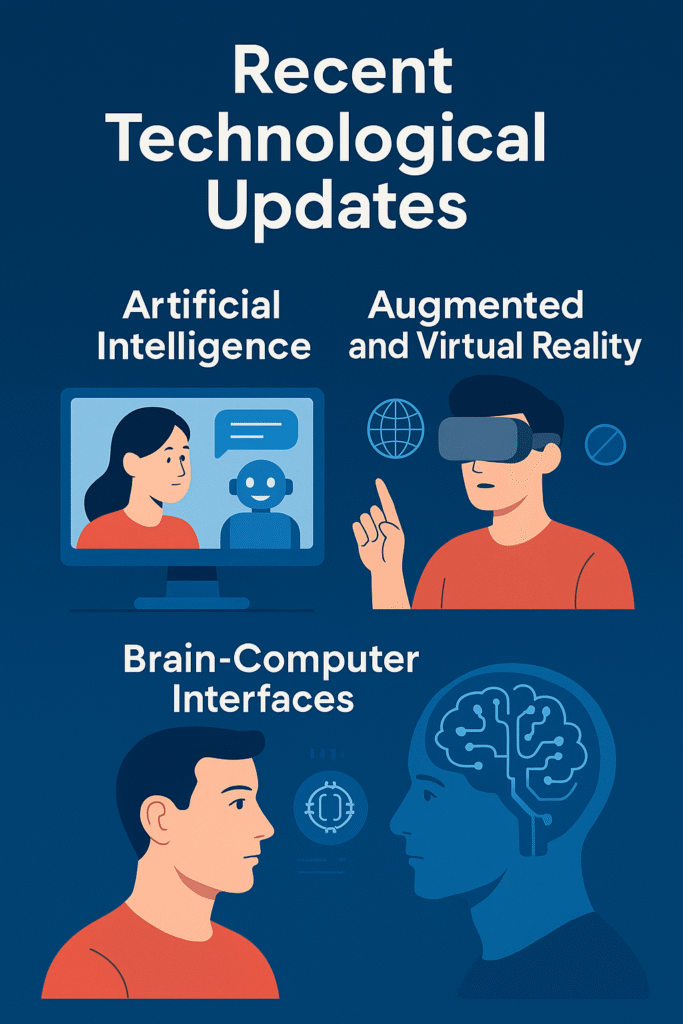The Future is Now: How AI, AR/VR, and Brain-Computer Interfaces Are Changing Our World
Every few years, a wave of new technology rolls in and redefines the way we live, work, and interact. But in recent times, this wave has become a tidal surge, with advancements in Artificial Intelligence (AI), Augmented and Virtual Reality (AR/VR), and Brain-Computer Interfaces (BCIs) pushing us further into what once felt like science fiction. The future is no longer something we’re waiting for—it’s happening all around us.
Whether you’re a student, a parent, a business owner, or just someone who enjoys scrolling through social media, these technologies are touching your life in ways you may not even realize. Let’s explore what’s new in each of these exciting areas and what it means for all of us.

1. Artificial Intelligence: Smarter Than Ever
AI is everywhere—from your smartphone’s voice assistant to recommendation algorithms on Netflix. But recent advancements have taken things to a whole new level.
Generative AI: Creating Content with a Click
Generative AI, like OpenAI’s ChatGPT and DALL·E, can now write articles, compose music, generate art, and even create videos—all from simple text prompts. This has huge implications for industries like marketing, design, education, and entertainment. For example, small businesses can now create professional-level ads without hiring a full creative team Brain computer interface research .
AI in Healthcare
AI is also transforming healthcare. Recent models can diagnose diseases from X-rays and MRIs with surprising accuracy. AI-powered virtual health assistants are helping doctors and nurses manage patient care more efficiently, and drug discovery is accelerating thanks to machine learning. Brain computer interface research
Everyday Impacts
Even if you’re not in a tech-related job, AI is likely helping you more than you think. It’s behind spam filters in your email, personalized playlists on Spotify, and fraud detection when you use your credit card. In short, AI is quietly becoming your digital co-pilot. Brain computer interface research
2. Augmented Reality (AR) and Virtual Reality (VR): The Digital and Physical Worlds Are Blending
If you’ve ever used a Snapchat filter, tried on glasses virtually, or played a game in VR, you’ve already had a taste of what AR and VR can do. But things are about to get a lot more immersive.
AR: Enhancing Reality
AR overlays digital information onto the real world. Apps like IKEA Place let you see how furniture would look in your living room before buying it. Google’s AR directions can guide you through city streets by superimposing arrows and landmarks on your phone screen.
Apple’s recent launch of the Vision Pro headset is pushing AR into new territory, blending apps, entertainment, and real-world interaction into a seamless visual experience. This isn’t just fun—it’s practical. Imagine surgeons using AR to see vital stats during operations, or engineers fixing complex machines with on-screen guidance.
VR: Entering New Worlds
VR, on the other hand, fully immerses you in a digital environment. Whether it’s training pilots, conducting therapy sessions, or creating virtual classrooms, VR is proving it’s not just for gaming anymore.
Companies are using VR for employee training, architects are designing buildings in 3D spaces, and therapists are using it to treat PTSD and phobias. Even fitness is getting a virtual twist, with apps like Supernatural turning exercise into a game.

3. Brain-Computer Interfaces (BCIs): Technology Meets the Mind
Perhaps the most futuristic—and mind-blowing—development is in brain-computer interfaces. BCIs are devices that allow direct communication between the human brain and external devices. It might sound like science fiction, but it’s already becoming a reality.
What Are BCIs?
At their core, BCIs detect brain signals and translate them into commands. For instance, someone who is paralyzed could use a BCI to control a robotic arm, type messages, or navigate a computer just by thinking.
Elon Musk’s Neuralink and Beyond
Neuralink, founded by Elon Musk, recently made headlines by implanting a BCI chip in a human for the first time. The goal? To help people with neurological disorders regain function and, eventually, to merge humans with AI to stay competitive in a tech-driven future.
But Neuralink isn’t alone. Companies and universities around the world are experimenting with non-invasive BCIs using EEG headsets. Some early uses include helping stroke victims recover motor skills and enabling communication for people with ALS.
Everyday Potential
While we’re not quite at the point of downloading memories or telepathy, BCIs could eventually make everyday tech hands-free and more intuitive. Think of adjusting your music, writing a message, or even controlling smart home devices—just with your thoughts

What Does It All Mean for You?
These technologies aren’t just for tech geeks or Silicon Valley insiders—they’re shaping the world for everyone. Here’s how they could impact your daily life:
Education: Students can learn through interactive VR experiences or use AI tutors to get personalized help.
Work: AI tools can automate tedious tasks, giving you more time for creative or strategic work. VR can help you train for new roles, and AR can guide you on the job.
Health: From mental wellness apps using VR to AI diagnostics and even BCIs restoring mobility—your healthcare is becoming more accurate and personalized.
Entertainment: Movies, games, and music are becoming more immersive and tailored to your preferences, thanks to AI and VR.
Social Connection: AR filters, AI avatars, and VR meeting spaces are changing how we connect with others—across cities or across the globe.
Challenges and Considerations
Of course, with great power comes great responsibility. These technologies raise serious questions about:
Privacy: AI and AR rely on data—your data. How is it being used and protected?
Accessibility: Will everyone have access to these tools, or just the wealthy and tech-savvy?
Ethics: Should AI be making decisions about our health or safety? How do we prevent misuse of BCIs or deepfake technology?
Governments, companies, and individuals must work together to ensure these technologies are developed and used in ways that benefit everyone, not just a select few.
